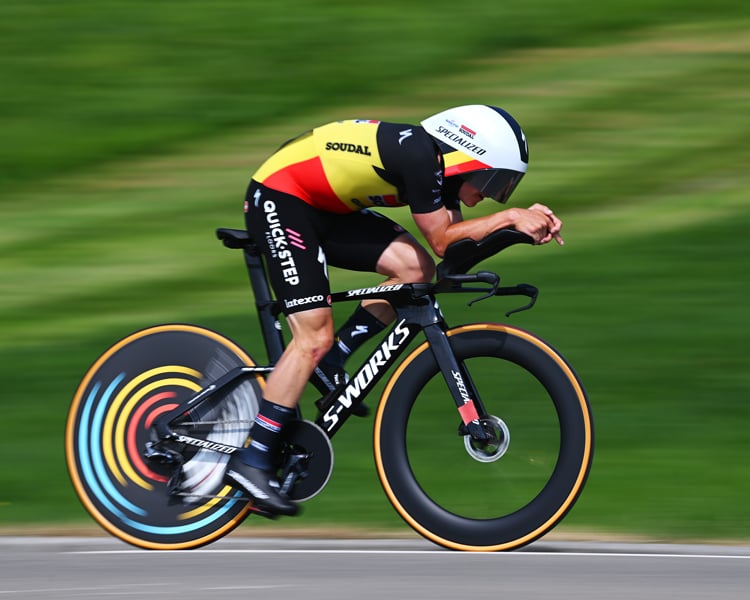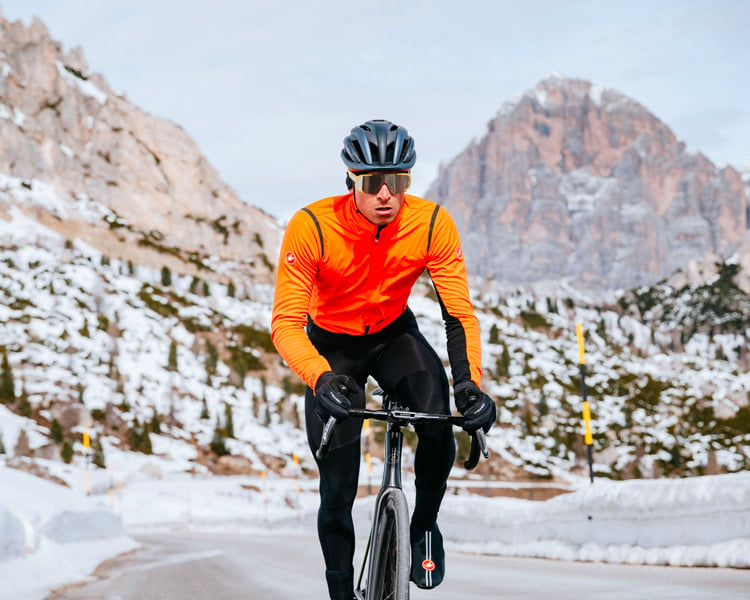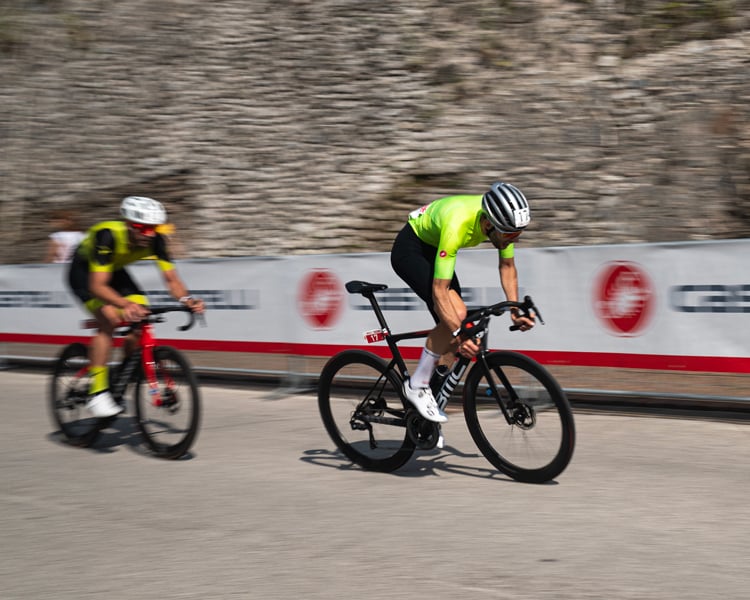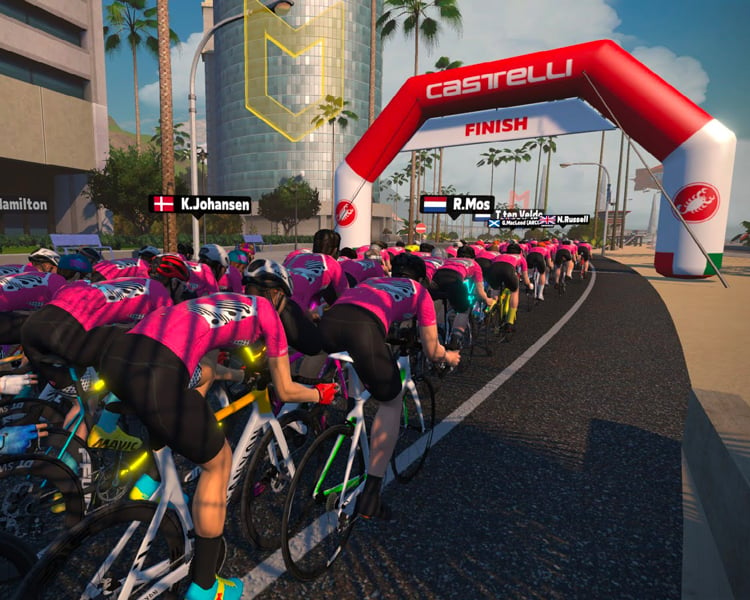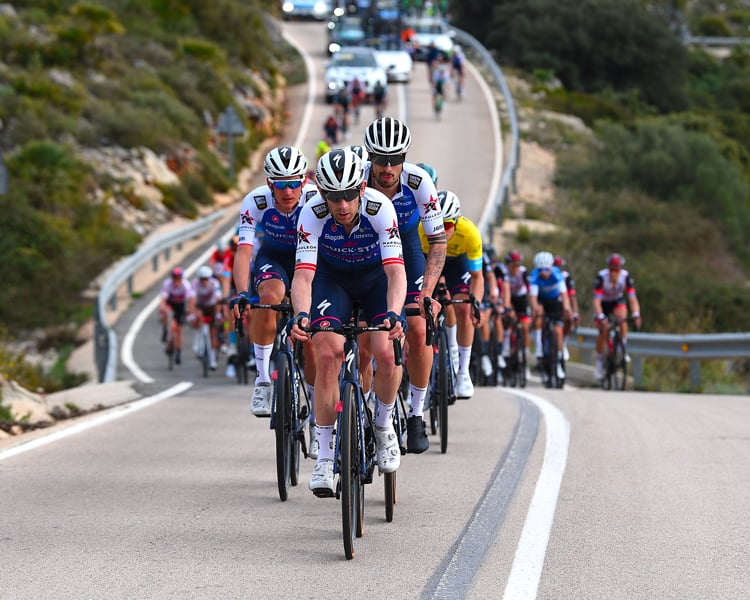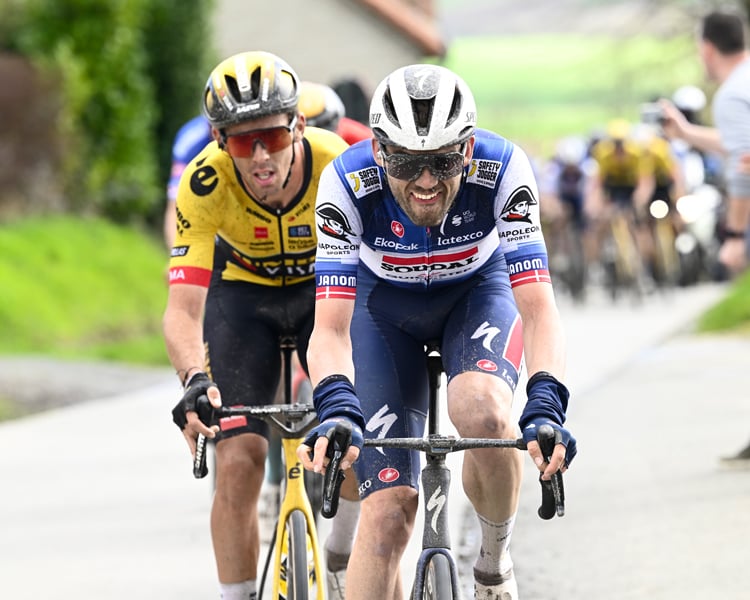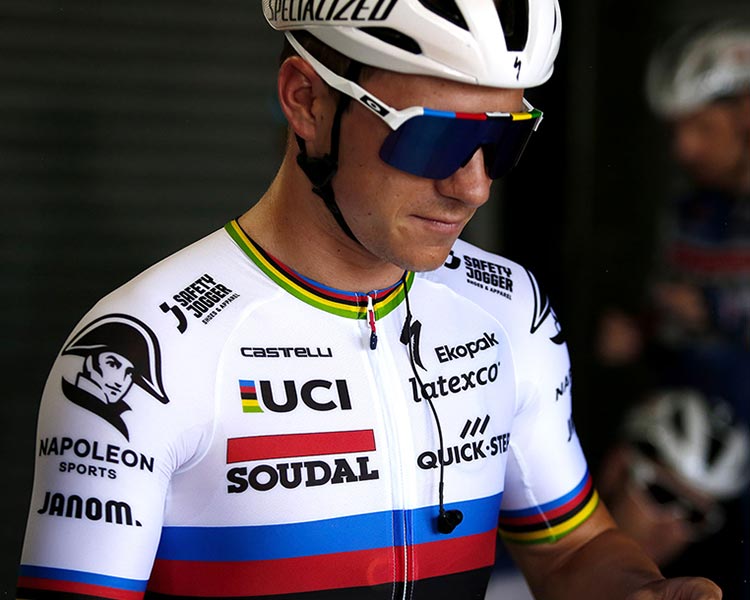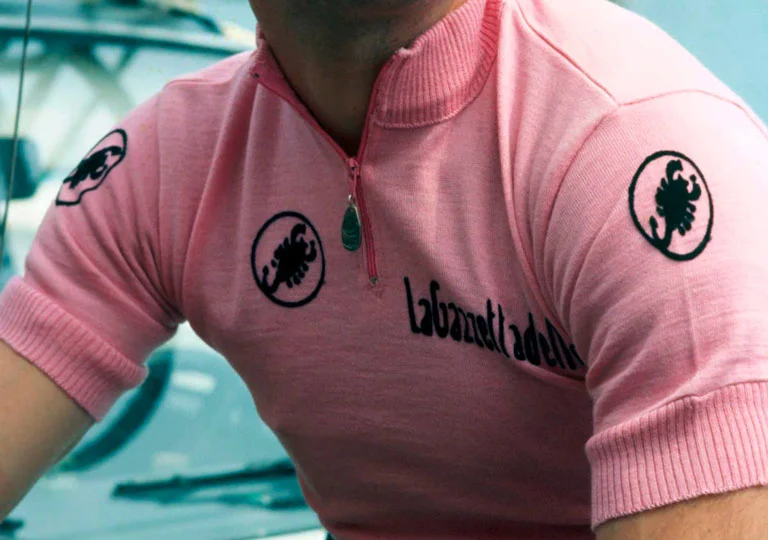
The 107th Giro d’Italia kicks off on Saturday, promising three weeks of breathtaking climbs, scenic views, and, above all, great racing. In this episode, we'll delve into some iconic moments in Giro history; the first Maglia Rosa, Marco Pantani's legendary attack to Oropa in 1999, Andy Hampsten's epic day on Passo Gavia in 1988, and Castelli's innovations and marketing stunts during the Giro, such as introducing turquoise Lycra shorts and the evolution of cycling jerseys.
TOPICS COVERED & TRANSCRIPT
00:00 Welcome
01:22 Castelli STRAVA Challenge
02:34 Marco Pantani's Legendary Attack To Oropa 1999
05:57 Passo Gavia 1988, Andy Hampsten's Epic Day
08:49 Castelli innovations, First Colored Lycra Shorts
09:42 Castelli innovations, Evolution of Cycling Jersey
14:09 Ending
COMMENTATORS
"In the meantime, Pantani has made a hole. Attention, Pantani is out. A moment. And he can't... We see that... 8.5 km to the finish line. In my opinion, he didn't make a hole, he had a chain jump. Because we saw him working on the gear behind.”
SOREN JENSEN
Watch out, Pantani has punctured! Well, actually, maybe it's not a puncture but a chain jump. The voices of Adriano De Zan and Davide Cassani, the two R.E.I. commentators in 1999 echoed through cycling history. Benvenuti a tutti and welcome to the Castelli podcast. The 107th Giro Italia kicks off this Saturday, promising three weeks of breathtaking climbs, scenic views, and above all, great racing. In the upcoming Castelli podcast episodes, we'll delve into the origins of the Giro Italia. The first Maglia Rosa, Castelli's 18 editions outfitting the leaders in the iconic jerseys, some of Castelli's innovative products introduced during the Giro and memorable race moments in history.
But before starting the show, we have some exciting news for you. To celebrate the Giro, Castelli is challenging you to ride 107 km over 2 weeks, matching the distance of as many km as Giro edition since 1909. To find out more, head over to Strava and click Challenges to find out how to participate in the Castelli “La Corsa Rosa Challenge”. By completing the challenge, you will earn a digital badge and receive a small promo on castellicycling.com. I'll also leave a link in the podcast notes. Now sit back, relax and kick your feet up as we embark on a thrilling and insightful journey into the Giro d'Italia. The Giro has often been described as the world's toughest race in the world's most beautiful country. And the Giro is guaranteed to be packed full of excitement every year. Over the next three weeks I'll pick six of my absolute favorite defining moments and iconic stages in Giro history to look back on.
My first one is how we introduced this episode, Marco Pantani's rocket ride to the Santuario di Oropa in the 1999 Giro. Pantani was undoubtedly the most thrilling climber of cycling's modern era. And despite his tragic death, his legend lives on. The 1999 Giro was made for climbers with Alex Zülle, Laurent Jalabert, Danilo Di Luca, Roberto Heras and Paolo Salvodelli all placed highly in the GC. By stage 15 though, which ended with a mountain top at Oropa after 160 kilometers, Marco Pantani was laying in wait, ready to strike. At the base of the main 11.8 km climb, Il Pirata unexpectedly slipped off the back of the main group with a mechanical. He lost nearly 30 seconds, but wasn't phased. Pantani fixed the problem and easily rode back to the group. The first one he caught was Ivan Gotti, around halfway up the climb, and began to stalk his targets more rapidly. By now the tifosi was swarming around him, a wall of noise and many helpful hands pushing him up the hill. Down in the drops, as we know him, his unique but classic climbing style, the 57kg Italian rode upwards, and seemingly into the sky.
As some of you probably remember, Pantani liked to dispose of something on the climbs before his real attacks, as a mental trigger, more than any weight differential. Usually it was his bandana, which he now swept off his bald head, before cutting through the multiple groups of scattered riders. Roberto Heras, Nicola Miceli and Laurent Jalabert had been pulling the bunch to keep clear of the attacking Pantani. GC contender Il Falco Paolo Salvodelli was a casualty and cracked early, fighting ungainly to contain his losses. At the 3km go mark, Jaja, Jalabair, was on his own and completely desperate looks over his shoulder like a girl in a horror movie and there was Pantani, Il Pirata, who didn't just pass him but stormed by. I remember reading somewhere that Jalabair in a post race interview said: “if I hadn't got out of the way, Pantani would have ridden right over me”. That day, Marco Pantani won the stage by 21 seconds. It could as well have been an hour. Such was the mental deficit to the other riders having destroyed them both physically and mentally. This Sunday, stage 2 of the Giro will take the riders from San Francesco al Campo to the Santuari of Oropa over 161 km, featuring the final climb of Europa with its 11.8 km at 6.2% to celebrate the 25th anniversary of the Skyward Ride which elevated Il Pirata even further into myth and legend.
Now number 2 of my list is Andy Hampsten's victory in the 1988 Giro, which saw him take the pink jersey on one of the most brutal and iconic stages in the race's recent history, crossing the 2,621 meter high Passo di Gavia in a blizzard. Hamsten reached iconic stages on stage 14 that year, but like many of life's great moments, the details don't matter. He never actually won the stage. But simply, the weather started getting rough, with reports of around a meter of fresh snow on the top of the climbs. The organizers, logistical skills disappeared and the stage was cancelled, then shortened, then reinstated, called off, called back on again, and while the riders huddled at the start like penguins. Off they go. The race was on. Hamsten set off in his short-sleeved Castelli Blue Combination classification jersey. Not his 7-11 team jersey. Because the Blue Combination classification jersey was awarded to the rider with most points obtained in the three main classifications. And of course a sweet pair of yellow Oakley factory pilots, but without a jacket, warm hat, gloves or shoe covers like most of the other riders. Many others did the same, including Johan van der Velde and GC leader Franco Chioccioli. Thankfully, the 7-11 director of sportif Mike Neal made a quick detour to a ski shop nearby to buy some warmer gear, but most of the teams were unprepared. During the climb, Hampsten was handed a pair of neoprene diving gloves, a neck warmer and a woolen beanie as the snowfall got worse. Shoving a La Gazzetta newspaper inside his jersey, Hampsten was now in the lead and heading down the steep and technical descent with numb hands on black ice to the finish line in Bormio. Not far behind but unable to see him in this sleet and snow, Breukink chased but was forced to take both feet off the pedals at times on the descent. Breukink managed to catch Hampsten in the last few kilometers while Hampsten hammered on, deciding to lose the battle to win the war. Breukink won easily, but Hampsten was now in the race lead. He kept the Maglia Rosa all the way to the finish in Vittorio Veneto, becoming the first non-Euro to win a Grand Tour and leading the headline of La Gazzetta dello Sport the following day to proclaim it, the day the big men cried.
Now, let's take a look at some of Castelli's innovations and marketing stunts introduced during the Giro. At the 1981 Giro d'Italia, for instance, Maurizio Castelli outfitted a handful of riders with turquoise lycra shorts at a time when only black shorts were allowed. The Castelli-equipped riders came to the start line wearing wool leggings to cover the band burst of color. With only a few minutes before the start, the riders would take off the leggings. A media frenzy followed, including day-long television coverage of the turquoise and scorpion-clad riders crossing the Italian countryside. The team and Castelli would receive daily fines, but no matter, the publicity was worth every Italian lire.
Another great innovation is the evolution of the cycling jersey. As the story of Castelli stretches back almost 150 years, predating the Scorpion logo, the Giro d'Italia, the Tour de France and even the Castelli name itself, which was first introduced in 1974. Well it all began in 1876 when a tailor named Vittore Gianni opened a small tailoring shop in the center of Milan. The same year the oldest and still existing bike race today on the calendar, Milano-Torino, was held. Vittore Gianni handcrafted clothing for local businessmen, the Milan Ballet and football teams such as AC Milan and Juventus. And with knowledge of sports clothing and movement, cycling was next to follow. The first cycling-specific clothing he made was in the 1920s for the world champion and five-time Giro d'Italia winner, Alfredo Binda. In 1935, a young Armando Castelli joined Vittore Gianni's staff. And only four years later, in 1939, Amando decided to purchase the company from Gianni, and the real story kicked into gear. Armando continued Gianni's support of high-profile clients, which by the late 40s included some of the biggest cycling heroes, names like Fausto Coppi, Gino Bartali, Louison Bobet, Rik Van Looy and Jacques Anquetil, who were all kitted out by Castelli. Along the way, the workshop expanded its efforts also to start supplying a handful of professional teams. At this time, the clothing, although made by Castelli, was still under the Vittore Gianni name. In the early 50s, Armando Castelli introduced silk jerseys to the peloton. Since wool proved efficient for wicking moisture and offering comfort due to its texture and stretch, however, wool jerseys posed problems in wet conditions, becoming heavy and baggy, and hindering airflow during mountain climbs. One huge advantage of using silk was its lightweight and moisture management. And for the sponsors it took ink extremely well. A highly desirable feature since having your company's name emblazoned on a rider's chest was paramount for effective advertising. And legend has it that Jacques Anquetil was the first cyclist to race in one of Castelli's silk jerseys.
And in 1952, Gino Bartali and Coppi both wore Castelli's silk jerseys branded Vittore Gianni as they battled for supremacy in the Tour de France. You probably remember that famous photo of them sharing a bottle over the Col de Galibier. The introduction of silk and new sublimation dye processes herald the beginning of the kaleidoscopic Peloton we see today. For its originator, the use of silk lent itself to new design touches, and Castelli soon began crafting jerseys with zips, pockets, and neck colors. Later in the years, new other fabrics, particularly lycra, paved the way for the man-made fabrics that were to follow. Lycra had the lightness and feel of silk, and could be combined with other fabrics to preserve the wicking qualities of wool, tight and aerodynamic, offering designers the opportunity to put into practice new research on ways that riders could reduce wind drag. And what's interesting here is that the first documented aero testing done by Castelli dates back to the late 1970s, where Castelli was crowned with the prestigious Corriere dello Sport Discobolo award. With the letters, Castelli has in a truly futuristic way revolutionized clothing for cyclists. And that's a wrap of this week's episode. Stay tuned for our next episode where we'll take a look at the Giro inauguration, the different leader jerseys, memorable moments in the Giro history and the most prolific winners of the Giro d'Italia's famous pink jersey, the Maglia Rosa. Till then, take care, celebrate the Giro d'Italia with us this weekend, join us for our other challenge, and hope to see you again next week. Ciao, ciao!
